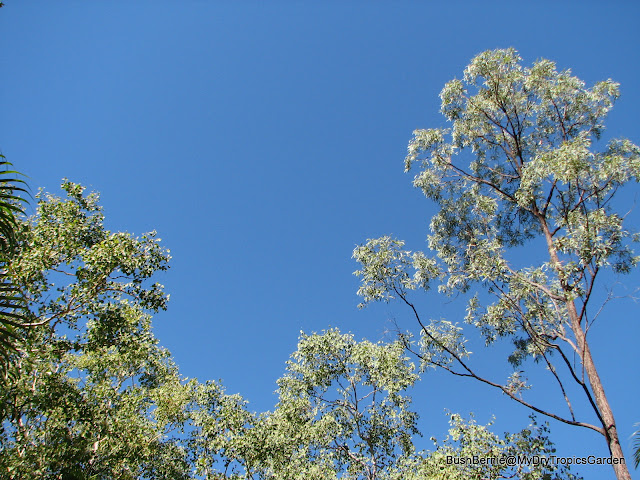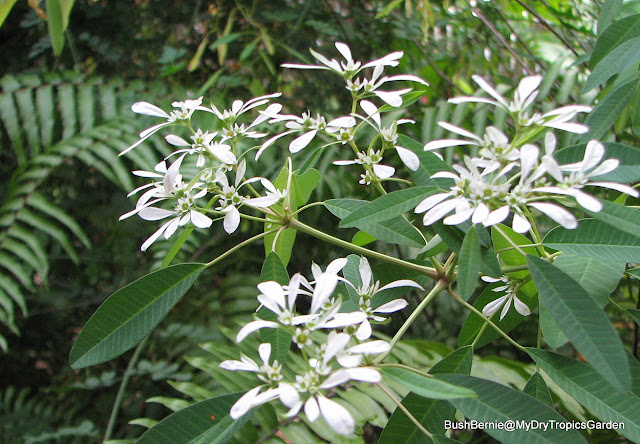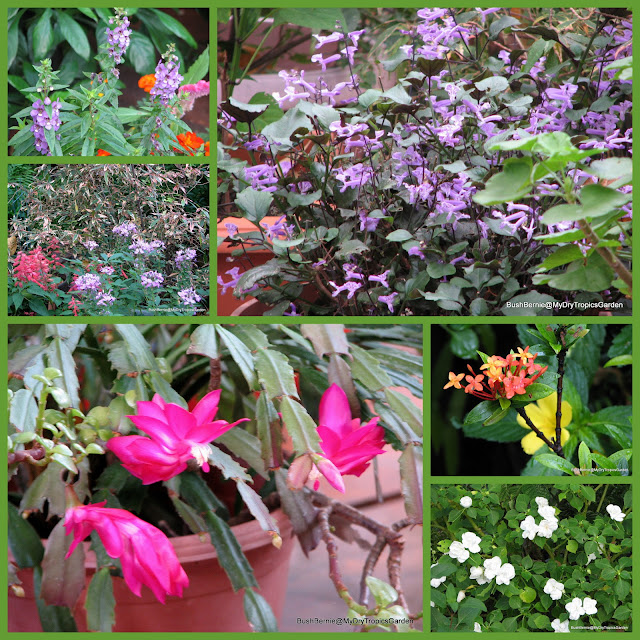Season: early Winter, and 'dry' season
It has been a while since I last added a Garden Journal post, and the main reason is simply that I haven't been doing all that much around the garden for some time now.
The Healthy Habitat Project, which centred mainly on the bush paddock and not on the garden areas here, did take up a lot of our time over the Autumn ... March, April and May ... but that's taken a back seat this month.
I have also been involved in lots of things that have taken me away from home on the weekends, which is my time for gardening. Anyway, enough of the excuses, let's see what's been going on around here.
June is the first month of our mild Winter. We have very reasonable temps and lots of sunny, big blue-sky days during our wintertime. It's only been in the last fortnight or so that I've had to uncover the electric blanket and dig out our winter jarmies and jumpers.
The courtyard garden is my preferred spot during our winters, because it's more colourful and lush-looking than all the other garden areas during our long dry spell.
It's the perfect place to sit out in, enjoy the blooms, and have a cuppa while we warm our chilly little fingers and toes. Good grief, the mercury has been dropping down as low as 10 and 11 deg C (50-51 F) some nights!!!
Even the Common Tree Snake has been hanging around the courtyard and spending time sun-baking on a branch of the Sterculia, in an effort to warm up. The poor thing!
Ah, now there's a gardening-related job that I have actually been doing lately. The native Steruclia quadrifida or Peanut Tree is a winter-deciduous tree and it's been dropping its leaves all over the courtyard garden over the last few weeks. I've been busy sweeping up the mess every couple of days just so my potted plants don't get smothered by the tonne or so of falling leaves.
This was the scene AFTER I'd swept a whole load of leaves off the pavers, and turned around to see more of them! It really is a never-ending job at this time of year, but I don't mind.
Our daytime temps. hover around 24-25 deg C (75-77 F) most days, which is just ideal for walking around the property, having a chat with a few flower friends and listening to the fabulous bird song, while I ponder the jobs I should be doing.
I get to see some fantastic bird life out here in the foothills. Just in the last couple of weeks I've spotted ...
... top row L to R: Pheasant Coucal and male Yellow-Bellied Sunbird
... middle row L to R: Cuckoo Shrike, Spangled Drongo and Laughing Kookaburra
... bottom row L to R: female Yellow-Bellied Sunbird and Whistling Kite.
Then there are the regular wildlife visitors like our Agile Wallabies
At the moment they're visiting our yard every day in search of food. It's dry season here now and the grass supply is dying off, so the wallabies are now digging down for the tasty grass roots.
It means our side and front yard look a bit like a construction site with deep holes everywhere. We don't mind though. Our so-called 'lawn' areas are not meant to be show pieces. We treat these spots as large fire break areas between the bush and our house, and not as the spot for a wonderful lawn that needs to be kept lush and green all year round.
You can see what it's like at the start of our dry season. We've had no rain at all this month. Yes that's right, no rain for the entire month of June, but that's usual for this dry tropics zone. There's months of it to come yet too, as our dry season usually lasts until around mid-December.
The word 'tropics' is often rather misleading when it comes to our particular corner of the tropics. People make assumptions about gardening in this tropical zone, and most of those assumptions do not apply to here, especially not on this challenging property. It's nor a fertile corner of the tropics, and it's very dry for most of the year.
That front yard of ours turns into a dust bowl by the time our summer rolls around. But, as I said, it's not meant to be a show piece of verdant green grass blades. It serves a more practical purpose.
So with a rainfall total of 0 mm for the past month, and only 29 mm (1.1 inch) of rain last month, most of the plants around my place are taking a little downtime, conserving their energy while the ground dries out and raindrops become a distant memory.
As a result, there's not a whole lot blooming right now, but at least the foliage plants provide some interest.
The shedding Eucalyptus trees.
and the fabulous new green bark of the Corymbia torelliana, also provide something different to look at.
In the front-of-house garden beds, the Mussaenda have finished a blooming cycle, but you can just make out a few red Hibiscus blooms and red Russelia flowers. They are year-round bloomers, but definitely have less blooms during our dry season.
On the other side of the larger front-of-house garden bed, there are a few flowers opening up on the dwarf Azalea as well. It's been a strange little thing this year. I've been spotting a few flowers here and there pretty much since the beginning of Autumn, which is a little out of character. I'm not sure if this will interrupt its usual springtime show or not.
The larger and older Hibiscus rosa-sinensis shrub, out the front of the larger bed, has become a favourite of the marauding hordes of hungry wallabies in the last two years. They've really had a whale of a time feasting on the leaves of the poor thing again this year, and it's just a mangled wreck at the moment. I keep trimming it, and it always bounces back.
In the tiered garden beds, in front of the shadehouse, things look equally as miserable.
In the top tier, the Daylilies haven't begun blooming yet, the Pentas is fading, the Lagerstroemia indicas are deciduous at this time of year, the Callistemon is not blooming either, the Iris domestica has finished its blooming cycle once again, and the Justicia was almost completely consumed by some rather hungry wallabies.
The Euphorbia pulcherrima is starting to show its colourful bracts though, as it's a winter bloomer and will soon be covered in pink bracts and tiny yellow flowers.
There are also some new buds on my two Adenium obesum growing in the top tier.
Oh, and I'm so pleased to say that the latest packet of Adenium seeds sent by lovely fellow gardener blogger, Pitta, have sprouted,
and the seeds she sent previously have produced a little crop of Adenium babies. All I need now is some space to plant them out. I'm working on that. Anyway ... back to the tiered garden beds ...
In the middle tier, at least the combination of the Duranta repens berries and the Ardisia elliptica fruit add some colour.
One of the gardening jobs I did get around to over the last couple of days, was clearing out the bottom tier of the tiered garden beds. It was over-run by the Giant Sword Fern and plants like the Mandevilla, the Salvia leucantha and the Euphorbia 'Hip Hop' all got a very good trim back.
I also needed to cut back the Salvia madrensis which had turned ugly in the middle tier. It had reached nearly a metre and a half and was looking leggy and unattractive.
I ended up with an overloaded wheelbarrow of rubbish. The trellis which has sat in front of the shadecloth walls of the shadehouse had really deteriorated and had to be thrown away as well. I'm going to need something else for the Mandevilla to creep up now.
One of the reliable winter bloomers are the two Calliandra haematocephala shrubs at the entrance to our property. They're both throwing out more and more blooms every day, as we get further into our winter months.
The driveway garden beds don't get much attention for most of the year, but during the dry season I do have to turn on the irrigation system occasionally just to keep everything going.
The poor Crotons drop a lot of leaves at this time of year, because of the dry conditions, but the leaves do provide some mulch for the thirsty shrubs and keep in some of the moisture I provide when I eventually give them a deep watering.
I did a little bit of weeding, trimming back and clearing out of the newer rock garden section at the end of the long driveway, and then threw around some mulch to help these young plants get through the dry season.
In the other rock garden section I've added a couple of new plants, and I'll need to do some mulching there too.
I've added some more Tradescantia,
and some Aloe veras. Tough, drought tolerant, sun tolerant plants that will do very well in these spots.
The shadehouse garden is chugging along nicely. I've just re-potted, trimmed back and fertilised all the hanging pots of Impatiens walleriana on the rock wall side.
I now need to do the same with the hanging baskets of Dragon Wing Begonia.
Everything else just needs the occasional watering.
Most of the flowers are found in the courtyard garden at the moment ...
although I don't have as many pots of flowers as I usually do at this time. I've been a little tardy in my annual planting this year. At least the few I have got do provide some lovely colour.
Our sunrise and sunset skies have been doing the same thing. For some reason, we always seem to have more spectacular looking early morning and evening skies at this time of year. Maybe all that colour in the sky is a meant to cheer us up, as the landscape around us starts to dry up.
Thank goodness for the wonderful colours and patterns of the foliage plants as well. They're always such a pleasure to have around as the dry rolls on.





























































